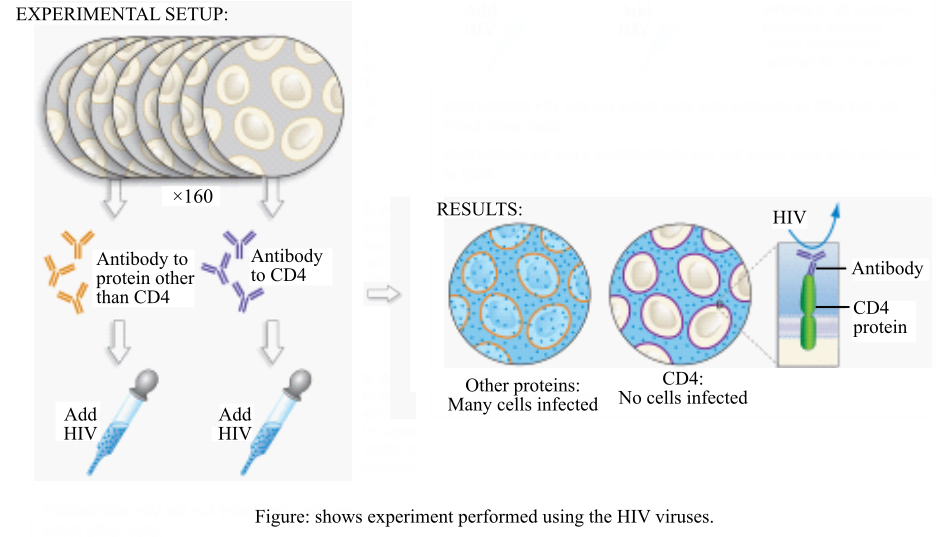
Concept explainers
To review:
The results of the HIV (human immunodeficiency virus) experiment and compare them with the Ebola virus (EBOV) experiment.
Introduction:
Ebola virus can lead to severe and fatal hemorrhagic fever in the human beings. The disease caused is known as Ebola virus disease. HIV is the subgroup of retrovirus (lentivirus) that leads to AIDS (acquired immunodeficiency syndrome). HIV utilizes CD4 (cluster of differentiation 4) receptor in order to enter the T helper cells. The cells that have free and unbound CD4 on their surface will be infected by the HIV. CD4 is a membrane protein that HIV utilizes to enter the cells. Similarly, researchers have identified many surface proteins that may work as a virus receptor for the EBOV. The figure below shows the experiment that was performed using HIV virus.

Experiment: One hundred sixty identical samples of T helper cells were grown in the culture. Different antibodies were then added into each sample of the cells. The antibody inhibits the specific membrane protein. A constant number of virions were then added to the samples followed by the incubation process under the conditions that are optimal for the viruses to enter.
Want to see the full answer?
Check out a sample textbook solution
Chapter 33 Solutions
Biological Science (6th Edition)
- The Adaptive Immune Response Is a Specific Defense Against Infection Researchers have been having a difficult time developing a vaccine against a certain pathogenic virus as a result of the lack of a weakened strain. They turn to you because of your wide knowledge of recombinant DNA technology and the immune system. How could you vaccinate someone against the virus, using a cloned gene from the virus that encodes a cell-surface protein?arrow_forwardFigure 17.6 Influenza virus is packaged in a viral envelope, which fuses with the plasma membrane. This way, the virus can exit the host cell without killing it. What advantage does the virus gain by keeping the host cell alive?arrow_forwardWhich receptor of the influenza virus is most involved in binding tothe respiratory cells?a. neuraminidase spikes b. hemagglutinin spikes c. the viral capsid d. the viral envelopearrow_forward
- The spike proteins of a coronavirus are one half of the Velcro mentioned in the video, and the other half of the Velcro consists of molecules on the surface of human cells. What happens after coronavirus spike proteins bind to molecules on the surface of a human cell?arrow_forwardMany viruses enter host cells through receptor-mediated endocytosis, What is an advantage of this entry strategy? A. The virus directly enters the cytoplasm of the cell B The virus only enters its target host cell type. C. The virus is protected from recognition by white blood cells. D. The virus can directly inject its genome into the cell's nucleus.arrow_forwardHow could a host cell use myosin to arrange actin such that a virus couldn't enter the cell?arrow_forward
- Explain that a virus can’t be treated with an antibiotic and why. Think about selective toxicity and why those targets don’t exist for a viral infection.arrow_forwardHow might a bacteriophage be used to treat a bacterial infection? – this question relates to question # 2. Address specificity. Why can viruses only infect specific cells? Why would the host cell be safe from infection?arrow_forwardYou would like to create an anti-viral medication that is active against both H5N2 and H5N1 strains of influenza. The best drug target would be: a. ribosomal protein production b. Hemagglutinin-mediated fusion c. Neuroaminidase-mediated buddingarrow_forward
- Explain the role receptor-mediated endocytosis (RME) plays in virus replication (lytic cycle). If you worked for a pharmaceutical company and wanted to develop a vaccine to prevent viral replication, how could you use your knowledge of RME to your advantage?arrow_forwardHumans often use many proteins to accomplish a single function while many viruses accomplish multiple functions with a single peptide. What is an example of a virus and its single viral protein that accomplishes multiple functions? Why is it that this virus must be so efficient (doing so much with only one protein)? Why is this not the case with humans and pathogens that are relatives of humans?arrow_forwardSome older vaccines used a weakened strain of the pathogenic virus in the injection in the hope that the weakened virus would induce an immune response without causing disease. The virus vectors used in genetic engineering have all the harmful virus genes cut out and replaced with the foreign gene, such as one that makes a protein that is absent in the human patient. Which type of viral vaccine would you prefer to take as the safest option? Why?arrow_forward
 Human Heredity: Principles and Issues (MindTap Co...BiologyISBN:9781305251052Author:Michael CummingsPublisher:Cengage Learning
Human Heredity: Principles and Issues (MindTap Co...BiologyISBN:9781305251052Author:Michael CummingsPublisher:Cengage Learning Biology (MindTap Course List)BiologyISBN:9781337392938Author:Eldra Solomon, Charles Martin, Diana W. Martin, Linda R. BergPublisher:Cengage Learning
Biology (MindTap Course List)BiologyISBN:9781337392938Author:Eldra Solomon, Charles Martin, Diana W. Martin, Linda R. BergPublisher:Cengage Learning Concepts of BiologyBiologyISBN:9781938168116Author:Samantha Fowler, Rebecca Roush, James WisePublisher:OpenStax College
Concepts of BiologyBiologyISBN:9781938168116Author:Samantha Fowler, Rebecca Roush, James WisePublisher:OpenStax College


